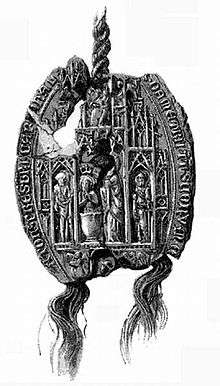Demetrius of Esztergom
| His Eminence Demetrius | |
|---|---|
| Cardinal Archbishop of Esztergom | |
 Seal of Archbishop Demetrius | |
| Archdiocese | Archdiocese of Esztergom |
| Appointed | 16 August 1378 |
| Term ended | 23 January 1387 |
| Predecessor | John de Surdis |
| Successor | John Kanizsai |
| Other posts |
Bishop of Zagreb Bishop of Transylvania Bishop of Syrmia |
| Orders | |
| Created Cardinal |
18 October 1378 by Pope Urban VI |
| Personal details | |
| Died | 20 February 1387 |
| Denomination | Roman Catholicism |
Demetrius (Hungarian: Demeter; died 20 February 1387), was a Hungarian cardinal and politician, who served as archbishop of Esztergom and bishop of Zagreb and Transylvania, and chancellor.
Origins and early career
Nothing is known about the origin of Demetrius, who would rise to the highest ecclesiastical titles, but it is presumed that he came from a family of peasants. His father was a certain Peter. He was raised together with King Charles I's eldest son, Louis, who would become King Louis I in 1342.
In 1356, he became Keeper of the Seals. Three years later, he was put in charge of the royal treasury. According to historian Pál Engel, the office of treasurer was emerged into permanent status by 1377, possibly on the initiative of Demetrius himself. At this time, he began his ecclesiastical career, becoming canon of Pécs in 1363 and provost of Eger. In 1364, Pope Urban V appointed him bishop of Sirmia but Demetrius did not assume the office until 1 April 1365. On 28 June 1368, Demetrius was also made bishop of Transylvania. During his tenure as bishop of Transylvania, Demetrius had a cloister built for the Order of Saint Paul the First Hermit.
As chancellor and cardinal
Demetrius, recently created Chancellor of the Kingdom (a post he would hold until his death), had to leave the court having been given the bishopric of Zagreb by Pope Gregory XI on 23 January 1376. On 16 August 1378, Pope Urban VI appointed him archbishop of Esztergom and made him a cardinal on 18 October. Demetrius never visited Rome as a cardinal and became papal ambassador in Hungary. As archbishop of Esztergom, Demetrius officiated at the funeral of King Louis I on 16 September 1382 and crowned Mary, Louis I's elder daughter and successor on the Hungarian throne, the following day in Székesfehérvár Basilica. In 1384, Cardinal Demetrius travelled to Poland accompanying Louis I's younger daughter, Saint Hedwig, who had been elected to succeed her father on the throne of Poland.
In August 1385, the Archbishop performed the marriage ceremony between Queen Mary and Sigismund of Luxembourg, thus infuriating the Queen's mother and regent, Elizabeth of Bosnia. The queen dowager wanted to retaliate to the marriage by trying to deprive the archbishop of his see.[1] Sigismund soon left the kingdom, enabling the Hungarian nobility to invite King Charles III of Naples, the heir male of Louis I, to claim the throne. Charles successfully invaded Hungary and dethroned Mary. On 31 December 1385, Demetrius crowned him king of Hungary in the presence of the former queen, Mary, and the queen dowager, Elizabeth. However, Queen Elizabeth had King Charles II stabbed to death in her apartments. Sigismund returned to Hungary shortly after to be crowned king as Mary's co-ruler, but Demetrius died before the coronation took place.
References
- ↑ Goodman, 223.
Bibliography
- Goodman, Anthony; Gillespie, James (2003). Richard II: The Art of Kingship. Oxford University Press. ISBN 0-19-926220-9.
External links
| Demetrius Died: 20 February 1387 | ||
| Political offices | ||
|---|---|---|
| Preceded by Demetrius Marjádi (?) |
Royal treasurer 1359–1370 |
Succeeded by John de Surdis |
| Religious titles | ||
| Preceded by Thomas |
Bishop of Syrmia 1364–1368 |
Succeeded by Stephen Paksi |
| Preceded by Dominic Szécsi |
Bishop of Transylvania 1368–1376 |
Succeeded by Goblin |
| Preceded by Stephen Kanizsai |
Bishop of Zagreb 1376–1378 |
Succeeded by Paul Horvat |
| Preceded by John de Surdis |
Archbishop of Esztergom 1378–1387 |
Succeeded by John Kanizsai |